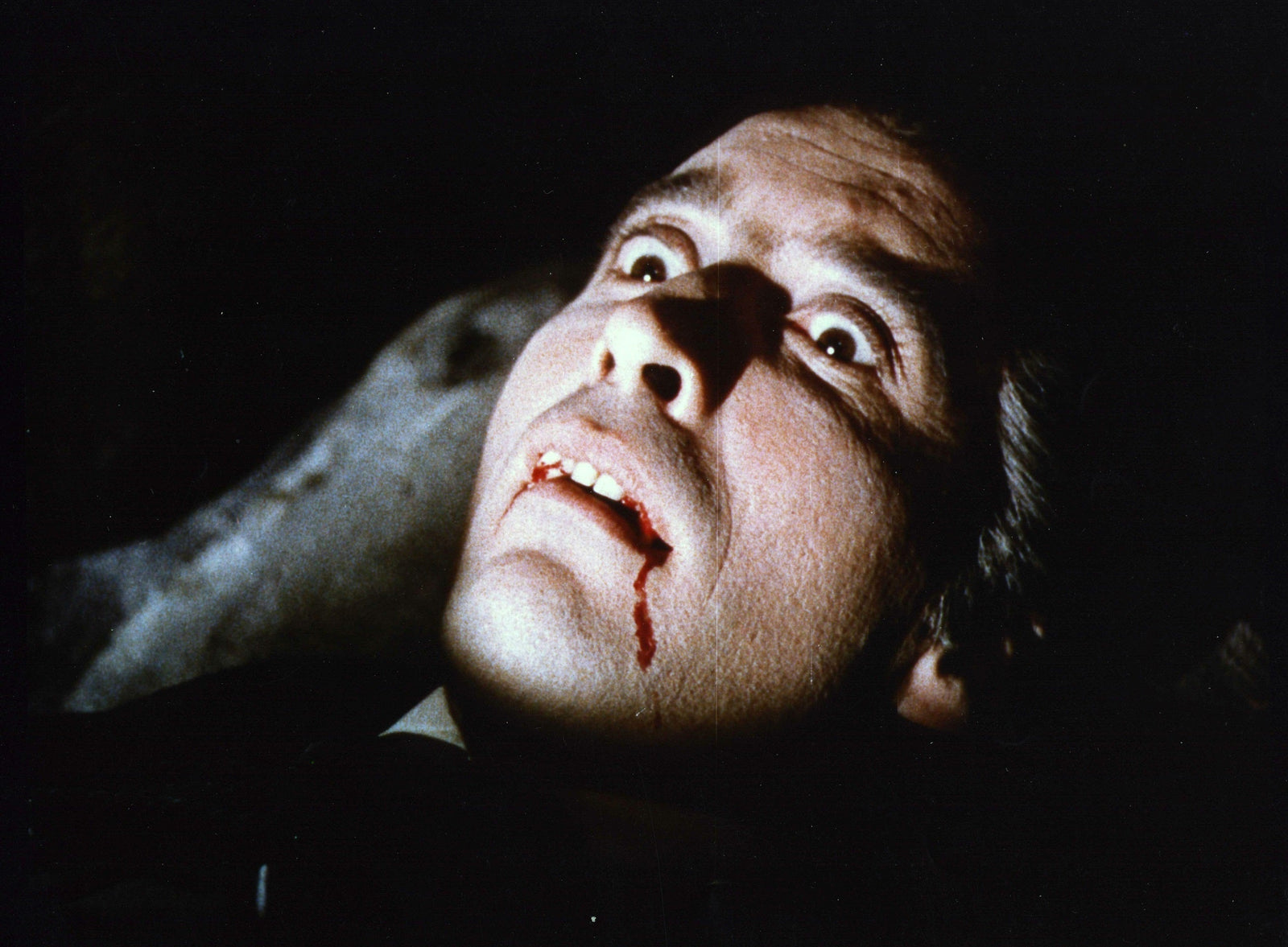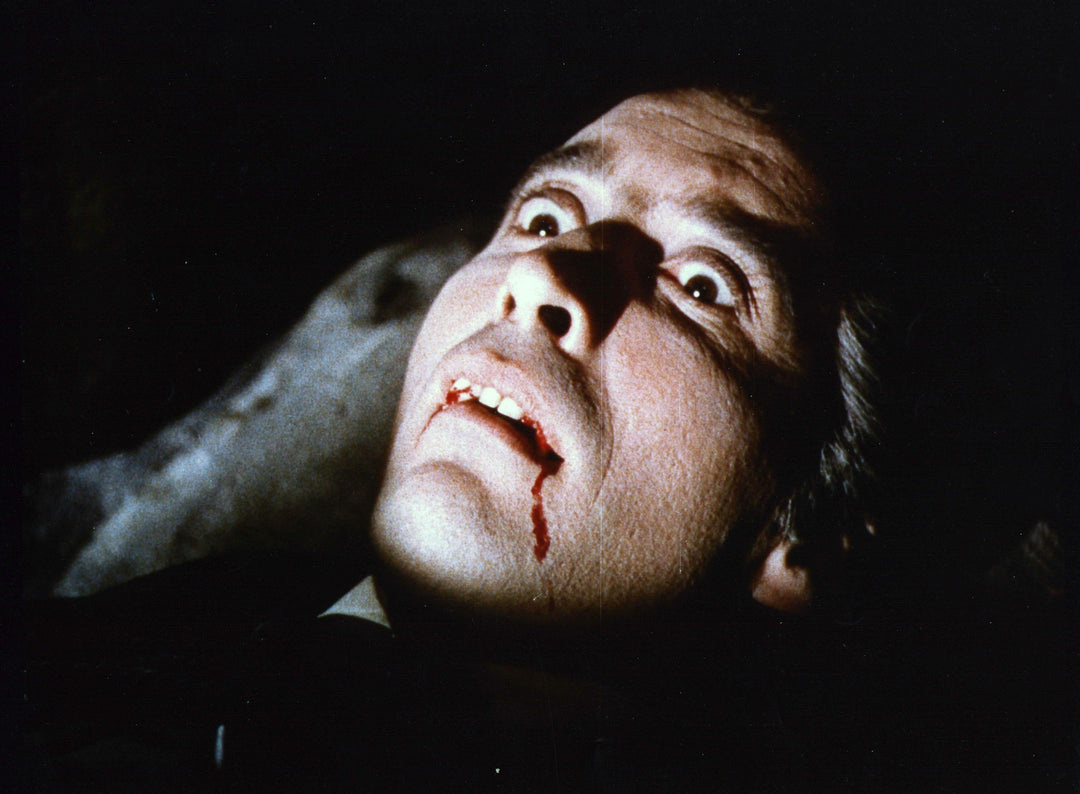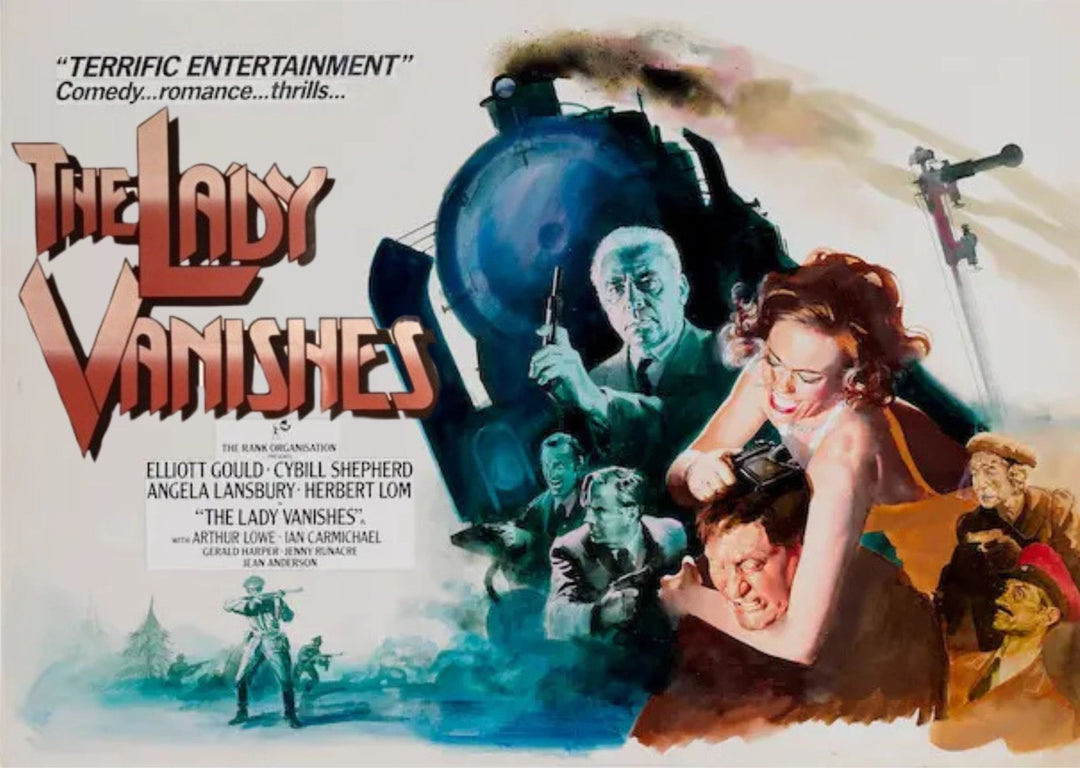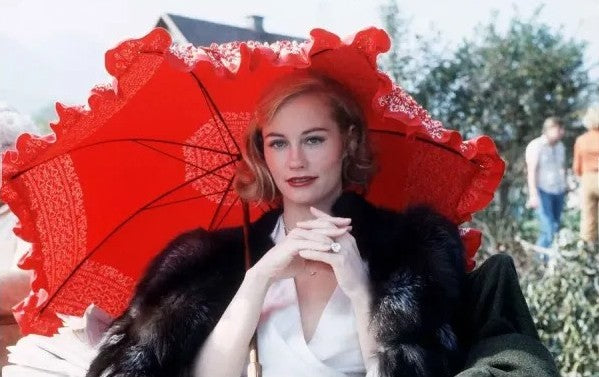Hallowe’en Special: The 12 Scariest Scenes in Hammer Films

As we hurtle towards the end of October, we’re here to make sure you’re watching the very best movies to celebrate Hallowe’en. Films that will put a smile on your face and send a shiver down your spine! To arm you with the most effective recommendations we’ve selected 12 of the scariest scenes in Hammer’s output since the 1930s. From the chilling and unnerving to the downright terrifying, we hope there’s something here for everyone…
THE CURSE OF THE WEREWOLF (1961)
Aside from the scene that takes the coveted number one slot, this list is in no particular order, but it feels appropriate to get the (monster’s) ball rolling with The Curse of the Werewolf. Director Terence Fisher insisted it wasn’t a horror, calling the picture an ‘adult fairy tale’. What could be more Hallowe’en than that?
Universal’s marquee monsters during their ‘Golden Era’ spanning the 1930s and 40s, were Count Dracula, Frankenstein’s ‘monster’ and the Wolf Man, or Larry Talbot to his friends. So having brought the first two fiends into the fold, it was perhaps inevitable that Hammer would eventually go in for a little lycanthropy. Their creative team was free to create any lupine lore they wanted, but chose to base their film, the first major werewolf movie filmed in colour, on Guy Endore’s novel, The Werewolf of Paris. However, as the execs had a load of Spanish sets at their disposal (long story, but a planned production fell through) it was decided to switch the story’s action to Spain.

Critic Chris McEneany called The Curse of the Werewolf, ‘Powerful, potent and poetic’.
By the tail end of Universal’s adventures with Larry Talbot, his transmogrification was being played for laughs. But choosing to adopt the approach they’d taken with Frankenstein and Dracula, Hammer portrayed the mythology seriously and ultimately made a movie that contains more melancholy than their previous horror flicks. The plight of Leon Corledo (‘Half-man… Half-wolf’ as the poster helpfully pointed out) is depicted as a tragedy, both for the individual and his loved ones. A human story, then, as opposed to a horror nightmare.
Nevertheless, the film is packed with terrifying moments and arguably, the scariest scene comes when Leon is still a child. At this point he only half-remembers ‘wolfing out’ (to borrow the terminology of the BBC’s Wolfblood), believing his recollections to be bad dreams. When he recounts them to his ‘uncle’, the compassionate Alfredo, there’s a quiet horror to the exchange.
‘He [Pepe] pulled the trigger and the little squirrel squeaked and dropped,’ the young boy explains. ‘It was horrible… I picked it up and tried to kiss it better. I kissed it, and I tasted something warm. It must have been the blood, but it tasted sweet. I wanted to keep on tasting it, but Pepe took it away. I did wrong, didn’t I, Uncle?’
It’s unnerving because we feel for the child, but the idea of him relishing the taste of blood is grotesque. That one so young should be so inhuman is uncomfortable on many levels, giving the recollections an added edge of awfulness. Leon wants the dreams to stop, and so do we. At this point it’s obvious Alfredo faces an uphill battle if he’s to keep the big, bad wolf away from the locals, with all their hatred, fear and sharpened axes.
Justin Walters deserves praise for his earnest and believable portrayal of the young Leon Corledo and Clifford Evans scores as his protector. The moment he looks down at the lad’s hands and sees clumps of fur across his flesh is the moment that things get hairy in more ways than one…
COUNT HIM IN…
We couldn’t have a Hallowe’en party without inviting Dracula along! Although there are many scenes we could select for inclusion, we’re plumping for another ‘reveal’, in this case the moment in Dracula (1958) where we’re introduced to Lee’s version of the vampire. We recently covered the moment in detail, and you can catch our analysis in I am Dracula…

Jared Harris (who plays Coupland) revealed he was a fan of horror movies and grew up watching Hammer classics including the Cushing Frankenstein films.
THE QUIET ONES (2014)
You’ve heard the expression, ‘It’s the quiet ones you’ve got to watch’? Well, we couldn’t agree more. This film ticks all the boxes you might have on your Hallowe’en movie checklist. Haunted house? Tick. Plenty of jump scares, a mysterious malevolent power and misguided scientists confidently tinkering with forces they can’t possibly understand? Tick, tick, tick.
The film focusses on Joseph Coupland (Jared Harris on fine form) and his small band of assistants / followers as he attempts to prove that supposedly supernatural phenomena have a basis in traditional science and, where appropriate, can be cured. His research centres on the troubled, enigmatic Jane (Olivia Cooke) who may or may not be ‘possessed’ and endowed with other worldly powers. And, yes. We all know how this is going to play out, but watching the mayhem unravel is enormously entertaining.
Scariest scene? Take your pick. The final moments where we see what’s happened to Brian, the team’s cameraman, with its full-circle twist offers a lovely touch of the macabre. Even the end credits, where we supposedly see the real-life participants of the experiments which The Quiet Ones is said to be (kinda sorta) based on, are strangely chilling as they suggest everything we’ve just witnessed has a genuine precedent. (Incidentally, in truth, the photos in the credits were created for the movie and the figures they feature are actors. Look carefully and you’ll see one of the younger individuals is Daisy Ridley, who would later follow in the footsteps of Cushing and Christopher Lee and take a major role in the Star Wars franchise.)
But for us, the scariest scene is where the gang finally realise Jane’s supernatural powers aren’t simply genuine, but are much more powerful than they’d dared to imagine. We see her controlling elements outside of her ‘cell’ and for the petrified scientists there’s a dawning realisation that they aren’t keeping their subject prisoner. It’s Jane who has captured them all…

The child talks to her doll as if it’s entirely human, and makes the same mistake with what’s left of Victor Carroon.
THE QUATERMASS XPERIMENT (1955) AND QUATERMASS 2 (1957)
If you prefer a Hallowe’en without full on horror, but still fancy a few scares to round out the month, the first two Quatermass movies might be just what the Professor ordered.
The passage in The Quatermass Xperiment where Victor Carroon, by now infected and possessed by a killer alien entity, meets a young girl on waste ground, takes tension levels higher than one of the title character’s rockets. The child (played by Jane Asher) is low key charming, but not too saccharine. She’s also alone and as she chats to her doll, it emerges she’s been rejected by other children, so we already feel for the kid. In fact we spend a minute and a half with her before Carroon finally steps from his hiding place, the boat, and walks towards her. In that time we can’t help but develop a fondness for the solitary child, but we sense Carroon must inevitably confront her, an awareness that director Val Guest expertly uses to build a sense of dread. Will he clout her? Kill her? It doesn’t help that marketing material for the movie included an image which suggests he attacks her…
When Carroon finally lumbers towards the youngster we’re aware he’s already attacked and murdered a blameless chemist, meaning her innocence offers no shield. Although we’re hoping she’ll run, it's already been established she wants company, and so, of course, she invites the monster to join her and have a make-believe bite to eat. (‘Oh! We thought you were rats. Won’t you stay and have tea with us?’) This will-he-won’t-he? interaction is one of the film’s highlights and offers a superbly scary interlude.

Sid James (who plays reporter, Jimmy Hall) was credited as Sydney James in the film, but Sidney James in much of the marketing and publicity.
For a different kind of scare, we’d pick out the slaughter of reporter Jimmy Hall, played by Sid James in Quatermass 2.
In season 2 of Blake’s 7 (stay with us here), series regular Olag Gan was killed off during an attempted attack on the evil Federation. The production team was surprisingly open about the reason for his demise. They revealed his death was a way of letting the viewers know that nobody was safe. This knowledge upped the fear factor as audiences would never have the comfort of knowing their favourite characters would definitely make it through the drama of the week. (Incidentally, the show’s creator, Terry Nation, had suggested killing off Vila, but he was deemed too popular.) This ‘trick’ has subsequently been used in countless TV shows, from Misfits to Oz.
The technique is perfectly deployed in Quatermass 2. Hall is one of the film’s most charismatic and likeable characters. He’s the heart of his early scenes and it feels unthinkable he won’t survive the mounting threat. But as his impassive killers gun him down we’re being told not to assume anything. Any of the good guys – even our favourite characters – could lose their lives. The aliens could win. Maybe Quatermass won’t pull it out off the bag this time…

Isla Cameron in an early scene from Nightmare. Director Freddie Francis had previously worked with her when he served as Director of Photography on The Innocents (1961).
PUTTING THE ‘OH!’ INTO THE OPENING
Hammer has a happy knack of getting the start of their movies spot on, delivering opening passages that chill us, yet compel us to stay for more. Freddie Francis was a master of the art and directed our next two entries – the first few minutes of The Evil of Frankenstein (1964) and Nightmare (1964). We discussed them in a feature that covered some his best work for Hammer, and both films are perfect for the Hallowe’en season.
But in terms of scary starts, it’s hard to beat The Hound of the Baskervilles (1959). The sound of a storm. The image of the forbidding Baskerville Hall, set amongst desolate moors. James Bernard’s doom-laden music. And then we’re into the action, with Mortimer’s ominous voice over, ‘Know then the legend of the hound of the Baskervilles…’

The murderous Hugo Baskerville was played by David Oxley who shortly after featuring in this Sherlock Holmes movie, appeared in Hammer’s Yesterday’s Enemy (1959).
It’s a brutal start as Sir Hugo, undoubtedly one of Hammer’s vilest villains, essentially trades his soul to capture the woman who’s just escaped from his home. As he captures and kills her, we realise someone, or something, intends that he should pay for his crime, and sure enough we hear the howl of ‘the hound from hell’.
The colours, the pace, the injection of the supernatural element just as Hugo takes a life, as if the curse has been born through murder… These elements and more ensure it’s a gripping start to this Sherlock Holmes yarn, confidently stepping out of the shadows of the 1939 classic that introduced Basil Rathbone and Nigel Bruce as the Baker Street boys. Directed by Terence Fisher, Hammer’s iteration delivers plenty more chills, from tarantulas in a London hotel, to a life-or-death dash across desolate, eerie moors. But the scenes that get us underway take a lot of beating as we’re breathlessly informed the game is afoot.

Don’t go into the house! Spoiler: he goes into the house.
THE WOMAN IN BLACK (2012)
There’s plenty to chill your bones in this seriously unnerving tale of terror, but because it feels like a classic Hallowe’en fright, for the purposes of this list, we’re selecting the scene where Arthur (and his frankly magnificent hair) is walking towards Eel Marsh House, and glimpses a pale, spectral face in one of the upper windows. Obviously, in real-life, that would be a cue to turn around and head back to the local café for one more latte. But we’re in horror movie territory here, so the ghostly vision means the terrified traveller must hurry into the house, trudge through its spooky, quiet corridors and finally enter the chamber where the grim visage was spotted.
Of course, the room is empty. Apparently.
Arthur walks to the window. Looks through the pane and… Yes, it's a jump scare which the audience anticipates, but it’s so well done it still lands, and the whole scene is loaded with such a charged atmosphere that we have no hesitation in inviting The Woman in Black along to our Hallowe’en celebrations.

Mr Bilson, played by Edmund Willard (left), is confronted by Anton, played by Bela Lugosi who true to type, goes for the throat…
THE MYSTERY OF THE MARY CELESTE (1936)
There’s no easy answer to the question, ‘What was Hammer’s first horror movie?’ because there’s no easy definition that allows films to be slotted neatly into the genre. But directed by Denison Clift and inspired by the fate of the real ‘ghost ship’ that was found mysteriously abandoned in 1872, The Mystery of the Mary Celeste (released in the US as The Phantom Ship) is a strong contender.
It’s a remarkable film and like all the best Hammer horrors it takes its central premise absolutely seriously. There’s supernatural horror as the hard and hardy sailors fear that the presence of a black cat onboard is enough to doom them all, holding it to be some kind of albatross-like curse that brings inescapable misfortune. There’s the simmering horror of a murder mystery as the crew members start losing their lives, one-by-one. And there’s a grim, authentic horror as the shanghaied men react to their kidnappings with violence and rage.
The grimness is unremitting and when Sarah, the only woman aboard the ship, becomes the victim of an attempted assault by one of the crew members, her assailant is killed by Anton, a one-armed ‘sea dog’ played by Bela Lugosi. He’s already unsettled by the less than perfect voyage, and instead of the expected nonchalance that might normally accompany such an act of protection, Anton is shown to be devastated by what he’s done, haunted by the guilt of snuffing out another person’s life.
‘I’ve killed man!’ he sobs as a vast storm rages outside, ‘Oh god, I’ve killed my fellow man!’ The captain blithely attempts to congratulate him for saving his wife (he even declares ‘Good job!’ at one point) but the weight of what he’s done falls on the older man and slowly begins to crush him. It’s another curse of the Mary Celeste. Another crack in his sanity. Another step closer to the vessel’s eventual destiny of becoming a ‘phantom ship’. And wow, it’s a very scary old scene.

Writing about The Revenge of Frankenstein, Motion Picture Daily declared that Hammer ‘…have demolished once and for all the theory that horror films should always be in black-and-white’.
THE REVENGE OF FRANKENSTEIN (1958)
We’ve already had one Franken-fright in our list, but if you’re thinking of having the Baron over for Hallowe’en, there’s plenty of other terrifying scenes that feature Mary Shelley’s misguided scientist. The moment his patients turn on him (‘Keep your murdering hands off me!’) in The Revenge of Frankenstein (1958) develops into a slow, horrific redistribution of power that sees the title character fall victim to one of Hammer’s most disturbing attacks.
There’s something about the gradual, inexorable way the scene develops that makes it horribly gripping. There’s no creature to add terror to the moment, but the slow seep of the men’s advance on their physician, and his growing realisation of what he’s in for, make this one of the most chilling scenes in any Frankenstein movie.
It also makes it onto our rundown of scariest scenes in a Hammer picture. Of course, this isn’t a definitive list and it’s presented as a (hopefully!) enjoyable way to celebrate Hallowe’en, and a ghoulish guide to help you pick out a few films that play well this time of year. We could list dozens more moments and it seems criminal we’ve omitted titles like The Reptile (1966) and Fear in the Night (1972), but if we’d touched on every eligible candidate we’d be here till Hallowe’en 2026. And so, to recap the movies/scenes we’ve selected so far:
- The Curse Of The Werewolf: Young Leon recounts his taste for ‘sweet’ blood.
- Dracula: Our first encounter with the Count.
- The Quiet Ones: Jane shows the researchers who’s really in charge.
- The Quatermass Xperiment: A deadly human/alien hybrid is invited to tea.
- Quatermass 2: They can’t kill Sid James… Can they?
- The Evil of Frankenstein: A corpse is stolen and a child scampers into the dark, dark forest…
- Nightmare: The nightmare begins. Literally.
- The Hound of the Baskervilles: The devil rides in Dartmoor.
- The Woman In Black: A face at the window – run! No! The other way!
- The Mystery Of The Mary Celeste: Bela Lugosi in his only Hammer horror.
- The Revenge Of Frankenstein: The Baron’s patients take matters into their own bloodied hands.
But here at Hammer Towers we take scares seriously, so although the above ‘winners’ are in no particular order, we’ve saved the best till last, awarding top spot this year to a scene from a film that has recently risen again to strike terror into the hearts of audiences anew. Bubbling up at number one, we salute…

‘His limbs were in proportion, and I had selected his features as beautiful. Beautiful! Great God! His yellow skin scarcely covered the work of muscles and arteries beneath…’ – Mary Shelley’s original description of Frankenstein’s creation.
THE CURSE OF FRANKENSTEIN (1957)
The reveal of ‘the Creature’ in The Curse of Frankenstein stands as one of Hammer’s most famous and frightening scenes, and its ability to have a palpable effect on audiences remains as strong as ever. At the premiere for the restored, 4K version of the film, the moment Christopher Lee tears the bandages from his face triggered gasps and audible expressions of shock.
The moment works so well for a number of reasons. Jimmy Sangster’s script makes us wait a full 49-minutes before we see the Creature in all his gory glory. We’ve heard Paul’s warnings that the creation is a thing of evil and although we can understand Frankenstein’s motivations, we’re fully aware no good will come of his experiments, a pre-knowledge that serves to ratchet up our fears concerning the man-monster he’s cobbling together.
Terence Fisher’s direction is skilled and sly. We’re made aware the Creature is ‘fully’ alive when we see his chest gently rise and fall – no melodramatic hand twitching for Hammer! But following this development (which the film’s characters are unaware of) we have to wait to witness the ramifications as Paul and Frankenstein have yet another heated discussion which this time, the audience knows is irrelevant.
When the Baron leaves his former friend and hears glass breaking in the lab, we sense the reveal is – finally! – almost upon us. Frankenstein rushes forward and… Watch the way Cushing opens the door and presses himself against it, as if he’s physically ushering us into the room – forcing us to confront the horror his experiments have unleashed. And at that moment, James Bernard’s dramatic score kicks in. It’s been absent for the previous few scenes, but now returns with an unashamedly thrilling energy.

Reviewing the restored version of The Curse of Frankenstein, the Guardian praised the work’s ‘unpretentious energy and sly macabre gusto’.
The shot it accompanies, of the imposing, swaying figure is impactful enough, and we can’t help but share Frankenstein’s awe. But when the Creature removes the bandages from his head, revealing his features for the first time, shock levels go through the roof. The element of forced confrontation is continued as Fisher virtually slams us into the ‘reborn’ face with a bold close-up, and thanks to Phil Leakey’s masterful job with the make-up, there’s no anti-climax. Frankenstein strived to create something wonderful, yet in this brutal, awful reveal we see his achievement is the exact opposite.
The action becomes unrelenting as the Baron is immediately attacked by his creation. The one person who, up until this point, has always been poised and potent, is suddenly powerless, a rag doll in the grip of another’s fury. As the Creature chokes the life from Victor Frankenstein using his ‘beautiful’ second-hand hands, he shows the same level of focussed resolve that his victim has previously displayed. His expression, as he seeks to murder, is chilling in its intensity. Here then, is the true face of Frankenstein’s work. Here then, is the face of Hell itself.
Some of the films mentioned above are available from Hammer’s online shop. And whatever movies you decide to watch, and however you spend the spookiest season of them all, we wish you a very Hammer Hallowe’en!


